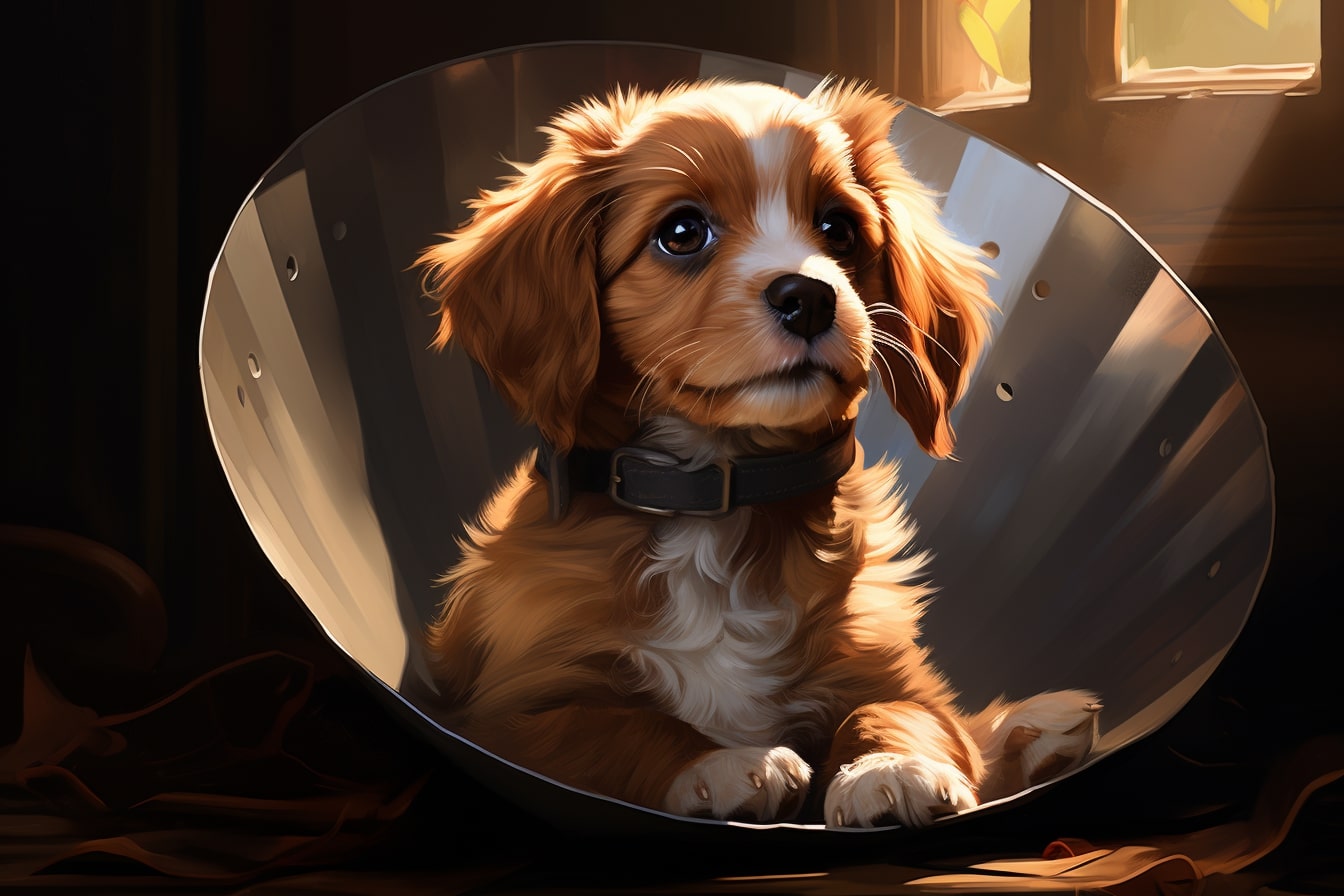Some pups take wearing the “cone-of-shame” in stride while others complain so much that their humans are forced to ask vets “When to take cone off dog after neuter?” If you’re a dog parent asking this question for your recently neutered pup, don’t worry, you’re not alone. More importantly, your dog isn’t alone in complaining about the discomfort of wearing a cone.
According to a recent study published in the journal Animals,most dogs ‘loathe’ wearing the cone of shame. Over 400 dog owners were surveyed in that study and most of them claimed that wearing a cone had highly negative effects on their dogs’ behavior and mental health:
- 60.2% of the dog owners who were surveyed claimed that their pets had severe difficulty drinking water because of the cone
- 67.5% said that their pets were unable to play freely because of the cone
- 25% said that the cones caused their dogs severe itching/irritation, collar-related injuries, psychological distress, and other physical injuries (e.g., falling downstairs, bumping into walls, etc.)
Most of the surveyed dog owners also stated that the cone had negatively impacted their pets’ sleeping, eating, social, and drinking patterns. So, if you’ve noticed that your dog runs the other way every time you try to put the cone on: don’t worry, this is 100% normal behavior.
Now, let’s move on to the real concerning question: “How long does the cone stay on after neutering dog?” Or even better, “Do dogs even need cones after spay?” The answer to the second question is yes. Even though your pup will exhibit all kinds of behavior to make you feel guilty, you must not take the cone off. Here’s why.
Do you want to know more about taking cone off after dog neuter? Then use the table of contents below to jump to the most relevant section. And you can always go back by clicking on the black arrow in the right bottom corner of the page. Also, please note that some of the links in this article may be affiliate links. For more details, check the Disclosure section at the bottom of the page.
Here's what we'll cover:
Do Dogs Have to Wear a Cone After Being Spayed?
Yes. Wearing a cone is an essential part of your spayed pup’s recovery process. That’s because dogs lick their wounds instinctively. If they’re not made to wear cones, they may lick their surgical wounds, rip off their stitches, and expose their wounds to infections. The cone will serve as a protective guard and stop your pup from being able to lick its wounds.
Your dog will hate wearing this shield. But, you must not cave in to their demands. The cone that vets give to dogs after neutering surgery is called an “Elizabethan collar” or “E-collar.” It’s typically made of plastic and designed to prevent licks, scratches, and bites to their wounds. Placing an e-collar on a dog is very easy:
The plastic cone offers much-needed protection and can make a huge difference in your dog’s recovery phase. But, as stated above, there’s no denying that dogs hate wearing these things. If your pup is extremely nervous or anxious about wearing the cone (to the point where they stop engaging in their day-to-day activities), it’s advisable to find alternatives.
Here are some alternative cones after neutering that you should consider using for your spayed pup:
Soft Collars
Soft collars look just like plastic cones. But, they’re made of soft fabric and not hard plastic. Hence, wearing soft collars is a much more comfortable alternative. However, unlike plastic cones, soft fabric collars aren’t transparent. Your dog won’t be able to see through this kind of cone. If your dog is naturally nervous and spooks easily, it may not like this aspect of soft fabric collars.
Inflatable Collars
Inflatable collars are less like post-surgery cones and more like inflatable pillows. But, they do the job. These collars are puffy, padded, and flexible. They give dogs the chance to increase their mobility, stretch out their necks, and access some regions of their lower body. Does it sound like something your pup needs? Here’s a helpful video guide on how to replace a traditional e-collar with an inflatable collar:
Some dogs may be too smart for flexible inflatable collars. They may maneuver their necks to access and lick their wounds. That’s why many dog owners don’t make their pets wear these collars constantly. Instead, they use it whenever they feel that their dogs need a break from a plastic cone.
Neck Collar
Made of plastic and foam, this collar is also less restrictive than the e-collar. Neck collars can be transparent as well so they’re ideal for ultra-nervous dogs that hate wearing e-collars.
Surgical Recovery Suit
These suits are meant for pups that vehemently object to having absolutely anything around their necks. Surgical recovery suits are made of soft fabric and they cover the dog’s whole body. These suits offer no room for dogs to access or lick their wounds.
No matter what type of cone, collar, or suit you pick for the dog: it must be approved by your veterinarian. Even if you make a ‘DIY collar’ for your pup, get it approved by the vet to make sure it meets acceptable standards of safety and effectiveness.
Can I Take The Cone Off My Dog After 7 Days?
Seven days post-surgery, you might be tempted to remove the cone, seeing your furry friend’s sad puppy eyes. But hold on, because the general guideline is to keep the cone on your dog for at least 10 to 14 days after neutering.
However, if you are keen on giving it a try after 7 days, it’s essential to monitor your dog closely to ensure they don’t try to lick or scratch the incision site, which can delay healing and potentially lead to infections. If your dog starts showing any signs of discomfort or attempts to reach the surgical site, it’s best to leave the cone on for a few more days to avoid putting your dog at risk.
How Long Does A Dog Have To Wear A Cone After Being Neutered?
The standard recovery time for a neutering or spaying surgery is about 10 to 14 days, during which it is recommended to have your canine wear the cone to prevent them from licking or scratching the incision site, which can hinder the healing process.
But let’s face it, dogs are pretty ingenious when it comes to finding ways to reach places they shouldn’t. That’s why it’s crucial to keep a close eye on them and ensure the cone is doing its job effectively. If you notice any redness, swelling, or discharge, contact your vet immediately.
Remember, it’s always better to be safe than sorry, and keeping the cone on for the full recommended period ensures that the surgical site is completely healed, putting your mind at ease and keeping your furry friend safe.
How Long Should Dog Wear Cone After Laser Neuter?
Laser neuter is a less invasive surgical procedure, which often means a slightly quicker recovery time. Generally, vets recommend keeping the cone on for about 7 to 10 days after a laser neuter procedure. This period allows air to circulate around the incision site, promoting faster healing.
However, it’s still vital to monitor your dog during this time. If your dog doesn’t seem bothered by the incision and is not trying to lick or scratch the area, you might be tempted to take off the cone earlier. But remember, even if your dog feels fine, the incision site might not have fully healed internally. It’s always best to consult with your vet before making the decision to remove your dog’s cone.
How To Make Dog Cone More Comfortable?
While it’s essential to keep your dog from licking and potentially harming the surgical site, it doesn’t mean they need to be uncomfortable. So, how can we make the cone-wearing experience a bit more bearable for our four-legged friends?
First things first, consider the material of the cone. While the traditional plastic cone is a go-to for many, there are softer alternatives available, like the comfy cone e-collar, which can be a bit gentler on your dog’s neck.
Next, let’s talk about size. The cone should be long enough to prevent your dog from reaching the incision but not so long that it obstructs their peripheral vision completely. It’s a delicate balance to strike, but getting it right can make a world of difference.
And hey, who says cones can’t be fun? Feel free to get creative and personalize your dog’s cone with some non-toxic markers. Maybe a few encouraging words or a cute drawing to lighten the mood?
Monitoring Your Dog While Wearing a Cone
Monitoring your dog while they’re wearing the cone is crucial to ensure they’re healing properly and not getting into any mischief (because we know how sneaky they can be!).
During the first 24 hours after neutering, it’s vital to keep a close eye on your dog to ensure they’re not experiencing any adverse reactions to the surgery. Make sure they’re able to eat and drink with the cone on, adjusting it as necessary to make it easier for your pet.
It’s also essential to check the incision site daily for signs of infection or other complications. If your dog accidentally damages the site, don’t hesitate to contact your vet.
Remember, it takes 10-14 days for the incision to heal fully, so patience and vigilance are key during this time.
Final Take
As we wrap up this post, it’s important to remember that while the cone may seem like a nuisance, it is essential in ensuring a smooth recovery process for your dog.
If you’re tempted to take the cone off your dog too early, resist the urge. The last thing we want is to prolong the healing process or cause any complications. Your dog should wear a cone for as long as your vet recommends, to ensure they fully recover within the estimated recovery period of two to three weeks.
Adapting to the dreaded e-cone of shame is no easy task for a dog. So, expect a lot of resistance from your furry buddy. To overcome this resistance, I recommend taking the following steps:
- Guide your dog to ensure they don’t bump into furniture or walls.
- Train your dog to walk with the cone on. For example, you can show your pup how to walk with their head held/neck high.
- Prepare their food/water bowls for easier access.
If your pup refuses to eat with the cone on, respond to their ‘peaceful protest’ by taking the cone off for a few minutes. But, this should be done only in rare circumstances where the dog is complaining too much.
And there you have it, dear readers! While the cone period might seem like it lasts forever, with a bit of patience and a lot of love, your dog will be back to their playful self in no time. Stay tuned for similar posts where we continue to navigate the sometimes tricky, but always rewarding, world of dog parenting. Stay pawsitive!
Thanks for the blog graphics: Canva.com
Doghint.com is a participant of several affiliate programs. The list includes (but not limited to) the following: VigLink, Refersion, ShareASale, and Amazon Services LLC Associates Program, an affiliate advertising program designed to provide a mean for us to earn fees by linking to Amazon.com and affiliated sites. Doghint.com does not intend to provide veterinary advice. All published articles are meant for informational purposes only and not substitute the professional veterinary consultation.


